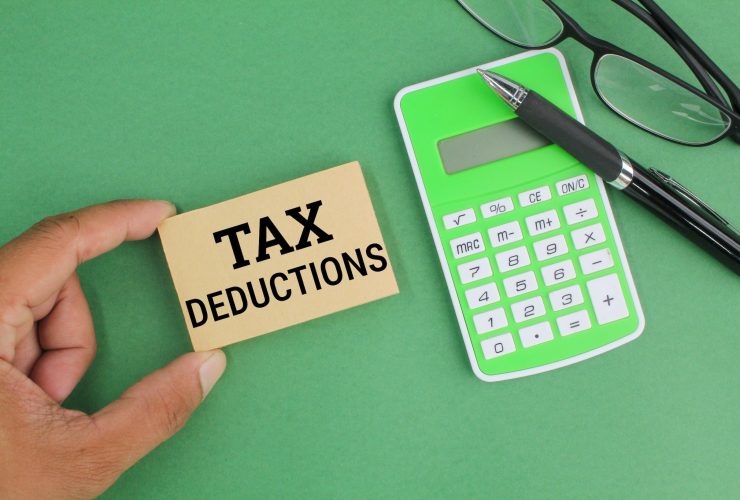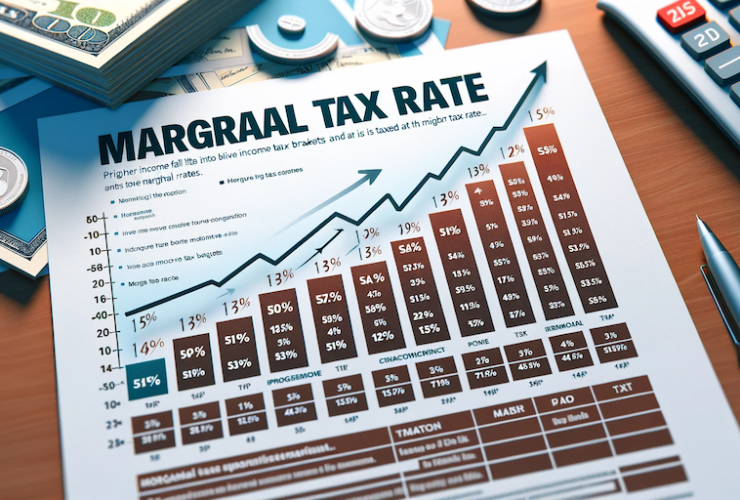What is Effective Tax Rate?
Effective Tax Rate (ETR) is the percentage of their total income that an individual or business actually pays in taxes. It is calculated by dividing the total tax paid by the total taxable income. This measure gives a clear and accurate picture of the tax burden on the taxpayer.
Understanding the True Tax Burden
ETR represents the true portion of income that goes to taxes, contrasting sharply with the nominal tax rates often discussed in tax brackets. It takes into account all deductions, credits, and varying rates across different income segments, offering a comprehensive overview of one’s tax obligations.
Contrast with Marginal Tax Rates
While the marginal tax rate applies to the next dollar of income (essentially the tax rate on any additional income earned), the ETR reflects the overall tax impact on all income. This distinction is crucial because the marginal rate can be misleading if taken as the cost of tax on all income. ETR, by accounting for the total tax paid over the total income, provides a more complete and meaningful financial picture, essential for accurate financial planning and analysis.
By comparing these two rates, taxpayers can better understand their financial landscape and make more informed decisions regarding investments, savings, and other tax-related matters.
How to Calculate Your Effective Tax Rate

Calculating your effective tax rate (ETR) gives you a clear picture of your actual tax burden. Here’s a straightforward formula to help you understand what percentage of your income goes to taxes:
- For an Individual:
ETR = (Total Tax Paid ÷ Taxable Income) × 100 - For a Corporation:
ETR = (Total Tax Liability ÷ Taxable Income) × 100
Example Calculation for an Individual
Consider John, who has a taxable income of $50,000 and has paid $7,500 in taxes over the year. To calculate John’s ETR:
ETR = ($7,500 ÷ $50,000) × 100 = 15%
This means 15% of John’s total income goes towards federal taxes.
Example Calculation for a Corporation
For a corporation with a taxable income of $300,000 and a total tax liability of $90,000:
ETR = ($90,000 ÷ $300,000) × 100 = 30%
This calculation indicates the corporation’s effective tax rate is 30%, crucial for assessing the impact of tax obligations on its profitability.
Factors That Influence Effective Tax Rate
| Factor | Impact on ETR | Description |
|---|---|---|
| Income Level | Direct | Higher income can lead to a higher ETR due to progressive tax rates. |
| Deductions | Reduces ETR | Common deductions include mortgage interest, charitable contributions, and state/local taxes. |
| Tax Credits | Directly lowers tax liability | Examples include the Child Tax Credit and Earned Income Tax Credit, which reduce ETR. |
| Location | Varies by state and locality | State and local taxes can significantly influence ETR, with some states having no income tax. |
| Financial Planning | Essential for optimizing ETR | Effective management of ETR aids in better financial decisions and resource allocation. |
| Investment Decisions | Affects after-tax returns | ETR impacts the profitability of investments, influencing choices based on net returns. |
| Business Strategy | Critical for operations | Influences decisions on business location, structure, and investment strategies to optimize tax. |
Several factors can significantly influence your effective tax rate (ETR), shaping how much of your income goes towards taxes. Understanding these factors can help you better manage your tax situation and potentially reduce your tax liability.
Income Level
Income level is a primary determinant of ETR due to progressive tax brackets. In a progressive tax system, as income increases, the tax rate on additional income also increases. However, because these higher rates only apply to income within specific brackets, the overall effective tax rate may be less than the highest marginal rate. Higher-income earners may have a higher ETR simply because a larger portion of their income is taxed at these higher rates.
Deductions
Both standard and itemized deductions significantly reduce taxable income, thereby lowering the ETR. Taxpayers have the option to take a standard deduction, which is a fixed amount deducted from income, or itemize deductions if the total of specific expenses (like mortgage interest, medical expenses, and charitable contributions) exceeds the standard deduction. By reducing taxable income, deductions decrease the overall amount of income that is subject to tax, effectively lowering the ETR.
Tax Credits
Tax credits are potent tools for reducing ETR because they reduce tax liability dollar for dollar, unlike deductions, which only reduce the amount of income subject to tax. Examples include the Earned Income Tax Credit, Child Tax Credit, and credits for education expenses. By directly lowering the tax bill, these credits can significantly decrease the ETR, often benefiting low to middle-income taxpayers the most.
Location
The impact of location on ETR arises from state and local taxes, which vary widely between different jurisdictions. Some states, like Florida and Texas, have no state income tax, which can lead to a lower overall ETR compared to states like California or New York, where state income taxes can be substantial. Additionally, local taxes, including property and sales taxes, must also be considered as they can affect the overall tax burden.
Each of these factors can play a significant role in determining the effective tax rate, making it essential for taxpayers to consider their entire financial picture when planning for taxes.
Why Does Effective Tax Rate Matter?
Understanding your effective tax rate (ETR) is crucial for several aspects of financial management, both for individuals and businesses. It influences decisions ranging from daily budgeting to long-term strategic planning.
Financial Planning
The ETR is invaluable for personal budgeting and financial forecasting. By knowing your ETR, you can more accurately predict how much money you’ll have left after taxes, which aids in making more informed decisions about spending, saving, and investing. It helps individuals plan for future financial needs, including retirement, by providing a clear picture of their net income after taxes.
Investment Decisions
For investors, the ETR can significantly impact the after-tax return on investments, which is a critical consideration for any investment strategy. Understanding the ETR helps in evaluating the true profitability of various investment options. For example, municipal bonds might be more attractive to individuals in higher tax brackets because the interest income is often exempt from federal taxes, which could lower their ETR on investment income.
Business Strategy
For businesses, the ETR is a key factor in several strategic decisions:
- Location Decisions: Companies often consider the ETR when deciding where to establish operations. Regions with lower tax rates can reduce the overall ETR, enhancing profitability. This is why some corporations choose to set up headquarters or substantial operations in states or countries with favorable tax laws.
- Structuring: The way a business is structured (e.g., LLC, S Corporation, C Corporation) affects its tax liabilities and thus its ETR. Businesses might choose a particular structure to capitalize on tax benefits, directly influencing their ETR and financial health.
- Investment Choices: Understanding the ETR helps businesses assess the viability and returns on potential investments. A project that seems profitable on a pre-tax basis might not offer adequate returns after taxes are considered, particularly in high-tax locations or sectors.
Overall, the ETR provides a clear, comprehensive measure of tax burden that is essential for making informed financial, investment, and business decisions. It helps both individuals and businesses maximize their resources and strategically plan for the future.
Tips for Optimizing Your Effective Tax Rate

Reducing your effective tax rate (ETR) can lead to significant financial benefits, freeing up more of your income for other uses. Here are some practical tips to help you optimize your ETR:
Maximize Deductions
Taking full advantage of available deductions is one of the most effective ways to lower your ETR. Here are some common deductions you might consider:
- Mortgage Interest: Homeowners can deduct interest paid on up to $750,000 of mortgage debt, which can substantially reduce taxable income.
- Charitable Contributions: Donations to qualified charities are deductible. Keeping detailed records of all contributions can maximize this deduction.
- Medical Expenses: Expenses exceeding 7.5% of your adjusted gross income can be deducted, which is particularly useful for those with high medical bills.
- State and Local Taxes (SALT): You can deduct state and local taxes paid, but note that there’s a cap of $10,000 on these deductions.
Take Advantage of Tax Credits
Tax credits reduce your tax liability directly and can be more beneficial than deductions. Some of the most impactful tax credits include:
- Child Tax Credit: Provides up to $2,000 per qualifying child and is refundable up to $1,400, which can significantly reduce your tax bill if you have dependent children.
- Earned Income Tax Credit (EITC): Aimed at low to moderate-income working individuals and families, the EITC can reduce the amount of tax owed and may provide a refund.
- Education Credits: The American Opportunity Credit and the Lifetime Learning Credit can help offset costs of higher education by reducing the amount of tax owed on your return.
Consult a Tax Professional
While many individuals and businesses manage their taxes independently, consulting with a tax professional can provide significant advantages, including:
- Expert Guidance: Tax laws are complex and change frequently. A professional can offer up-to-date advice tailored to your specific financial situation.
- Strategic Planning: Tax professionals can help plan for future tax years, identifying opportunities to minimize taxes through timing of income and deductions, retirement contributions, and other strategic financial decisions.
- Audit Support: In case of an IRS audit, having a tax professional who is familiar with your financial situation can be invaluable.
Implementing these tips can help you effectively lower your ETR, thereby increasing your disposable income or business profits. Whether through diligent record-keeping, making informed financial choices, or seeking expert advice, optimizing your ETR is a smart financial move.
Final Thoughts
The effective tax rate (ETR) is a crucial financial metric that provides a clear picture of the actual percentage of your income that goes towards taxes. Unlike marginal tax rates, which only apply to specific portions of income, the ETR reflects the total tax burden across all income, making it an essential tool for accurate financial analysis and planning.
I encourage all readers to take a proactive approach in understanding and managing their effective tax rate. Regularly calculate your ETR, explore ways to optimize it through deductions and credits, and consider professional tax advice if necessary. By using ETR as a strategic financial management tool, you can enhance your financial well-being and ensure that you are not paying more in taxes than you need to.
Frequently Asked Questions
What is an effective tax rate (ETR)?
How do you calculate the effective tax rate?
ETR = (Total Tax Paid ÷ Taxable Income) × 100




